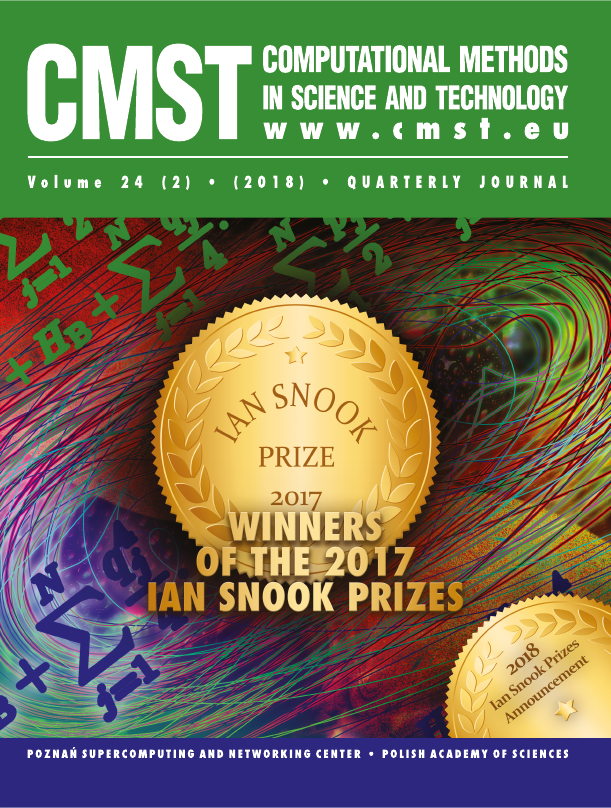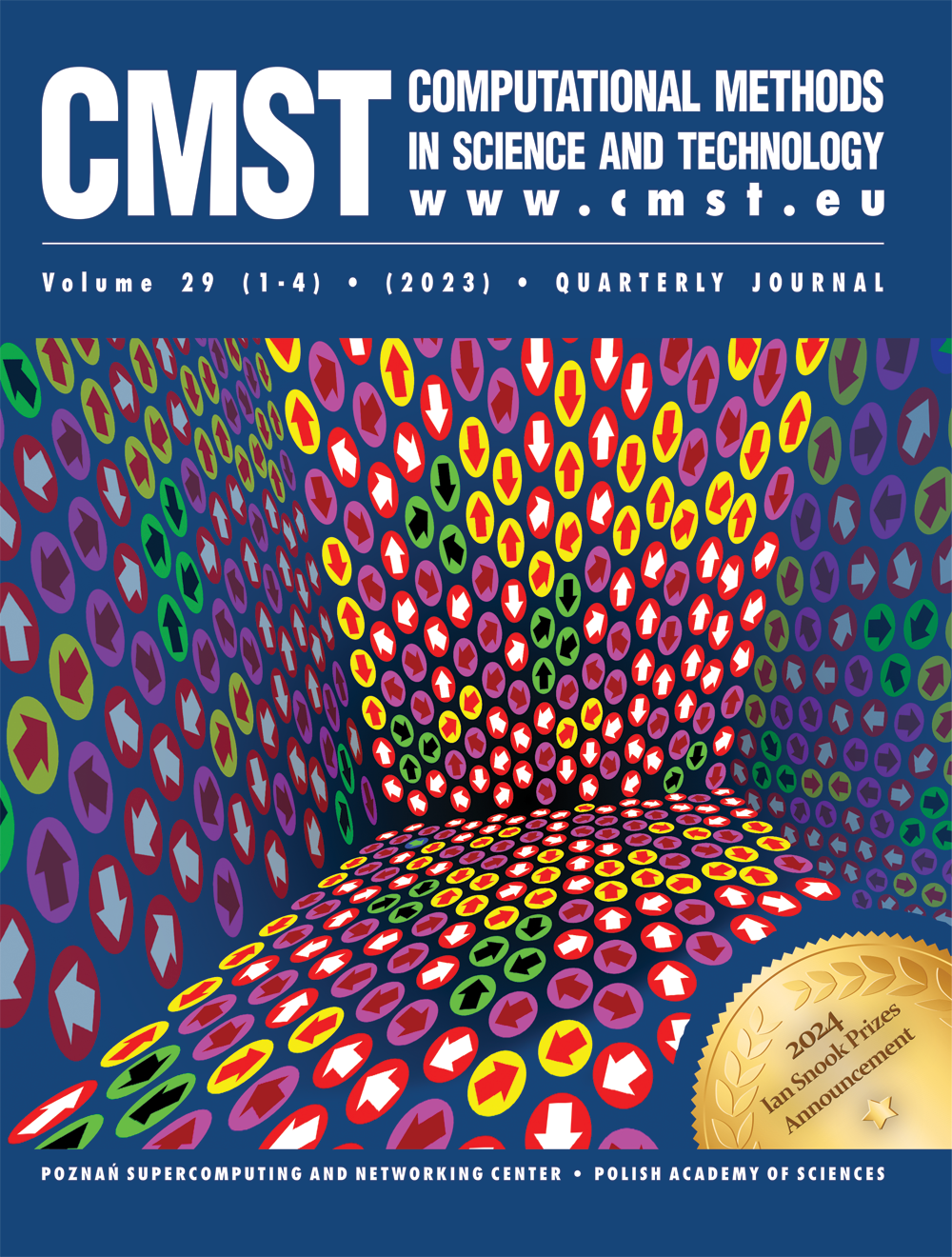Ergodic Isoenergetic Molecular Dynamics for Microcanonical-Ensemble Averages
Ruby Valley Research Institute
Highway Contract 60, Box 601, Ruby Valley, Nevada 89833, USA
E-mail: hooverwilliam@yahoo.com
Received:
Received: 25 June 2018; revised: 26 June 2018; accepted: 26 June 2018; published online: 30 June 2018
DOI: 10.12921/cmst.2018.0000035
Abstract:
Considerable research has led to ergodic isothermal dynamics which can replicate Gibbs’ canonical distribution for simple (small) dynamical problems. Adding one or two thermostat forces to the Hamiltonian motion equations can give an ergodic isothermal dynamics to a harmonic oscillator, to a quartic oscillator, and even to the “Mexican-Hat” (doublewell) potential problem. We consider here a time-reversible dynamical approach to Gibbs’ “microcanonical” (isoenergetic) distribution for simple systems. To enable isoenergetic ergodicity we add occasional random rotations to the velocities. This idea conserves energy exactly and can be made to cover the entire energy shell with an ergodic dynamics. We entirely avoid the Poincaré-section holes and island chains typical of Hamiltonian chaos. We illustrate this idea for the simplest possible two-dimensional example, a single particle moving in a periodic square-lattice array of scatterers, the “cell model”.
Key words:
References:
[1] S. Nosé, A Molecular Dynamics Method for Simulation in the
Canonical Ensemble, Molecular Physics 52, 255-268 (1984).
[2] S. Nosé, A Unified Formulation of the Constant-Temperature
Molecular Dynamics Methods, Journal of Chemical Physics,
81, 511-519 (1984).
[3] Wm.G. Hoover, Canonical Dynamics: Equilibrium Phase-
Space Distributions, Physical Review A 31, 1695-1697 (1985).
[4] Wm.G. Hoover, B.L. Holian, Kinetic Moments Method for the
Canonical Ensemble Distribution, Physics Letters A 211, 253-
257 (1996).
[5] G.J. Martyna, M.L. Klein, M. Tuckerman, Nosé-Hoover Chains:
the Canonical Ensemble via Continuous Dynamics, The Journal
of Chemical Physics 97, 2635-2643 (1992).
[6] Wm. G. Hoover, C.G. Hoover, J.C. Sprott, Nonequilibrium Sys-
tems: Hard Disks and Harmonic Oscillators Near and Far from
Equilibrium, Molecular Simulation 42, 1300-1316 (2016).
[7] D. Tapias, A. Bravetti, D.P. Sanders, Ergodicity of One-
Dimensional Systems Coupled to the Logistic Thermostat, Com-
putational Methods in Science and Technology 23, 11-18 (2017)
arXiv 1611.05090.
[8] I. Shimada, T. Nagashima, A Numerical Approach to Ergodic
Problems of Dissipative Dynamical Systems, Progress of Theo-
retical Physics 61, 1605-1616 (1979).
[9] G. Benettin, L. Galgani, A. Giorgilli, J.-M. Strelcyn, Lyapunov
Characteristic Exponents for Smooth Dynamics Systems and
for Hamiltonian Systems; a Method for Computing All of Them,
Parts I and II: Theory and Numerical Application, Meccanica
15, 9-20 and 21-30 (1980).
[10] F. Ricci-Tersenghi, The Solution to the Challenge in ‘Time-
Reversible Random Number Generators’ arχiv 1305.1805
(2013).
[11] N. Metropolis, A.W. Rosenbluth, M.N. Rosenbluth, A.H.
Teller, E. Teller, Equation of State Calculations by Fast Comput-
ing Machines, The Journal of Chemical Physics 21, 1087-1092
(1953).
Considerable research has led to ergodic isothermal dynamics which can replicate Gibbs’ canonical distribution for simple (small) dynamical problems. Adding one or two thermostat forces to the Hamiltonian motion equations can give an ergodic isothermal dynamics to a harmonic oscillator, to a quartic oscillator, and even to the “Mexican-Hat” (doublewell) potential problem. We consider here a time-reversible dynamical approach to Gibbs’ “microcanonical” (isoenergetic) distribution for simple systems. To enable isoenergetic ergodicity we add occasional random rotations to the velocities. This idea conserves energy exactly and can be made to cover the entire energy shell with an ergodic dynamics. We entirely avoid the Poincaré-section holes and island chains typical of Hamiltonian chaos. We illustrate this idea for the simplest possible two-dimensional example, a single particle moving in a periodic square-lattice array of scatterers, the “cell model”.
Key words:
References:
[1] S. Nosé, A Molecular Dynamics Method for Simulation in the
Canonical Ensemble, Molecular Physics 52, 255-268 (1984).
[2] S. Nosé, A Unified Formulation of the Constant-Temperature
Molecular Dynamics Methods, Journal of Chemical Physics,
81, 511-519 (1984).
[3] Wm.G. Hoover, Canonical Dynamics: Equilibrium Phase-
Space Distributions, Physical Review A 31, 1695-1697 (1985).
[4] Wm.G. Hoover, B.L. Holian, Kinetic Moments Method for the
Canonical Ensemble Distribution, Physics Letters A 211, 253-
257 (1996).
[5] G.J. Martyna, M.L. Klein, M. Tuckerman, Nosé-Hoover Chains:
the Canonical Ensemble via Continuous Dynamics, The Journal
of Chemical Physics 97, 2635-2643 (1992).
[6] Wm. G. Hoover, C.G. Hoover, J.C. Sprott, Nonequilibrium Sys-
tems: Hard Disks and Harmonic Oscillators Near and Far from
Equilibrium, Molecular Simulation 42, 1300-1316 (2016).
[7] D. Tapias, A. Bravetti, D.P. Sanders, Ergodicity of One-
Dimensional Systems Coupled to the Logistic Thermostat, Com-
putational Methods in Science and Technology 23, 11-18 (2017)
arXiv 1611.05090.
[8] I. Shimada, T. Nagashima, A Numerical Approach to Ergodic
Problems of Dissipative Dynamical Systems, Progress of Theo-
retical Physics 61, 1605-1616 (1979).
[9] G. Benettin, L. Galgani, A. Giorgilli, J.-M. Strelcyn, Lyapunov
Characteristic Exponents for Smooth Dynamics Systems and
for Hamiltonian Systems; a Method for Computing All of Them,
Parts I and II: Theory and Numerical Application, Meccanica
15, 9-20 and 21-30 (1980).
[10] F. Ricci-Tersenghi, The Solution to the Challenge in ‘Time-
Reversible Random Number Generators’ arχiv 1305.1805
(2013).
[11] N. Metropolis, A.W. Rosenbluth, M.N. Rosenbluth, A.H.
Teller, E. Teller, Equation of State Calculations by Fast Comput-
ing Machines, The Journal of Chemical Physics 21, 1087-1092
(1953).



